Maximizing Cumulative Trypsin Activity with Calcium at Elevated Temperature for Enhanced Bottom-Up Proteome Analysis
Abstract
:Simple Summary
Abstract
1. Introduction
2. Materials and Methods
2.1. Trypsin Activity and Stability Assays
2.2. Modeling Trypsin De-Activation Kinetics
2.3. Bottom-Up Proteome Sample Preparation
2.4. Bottom-Up LC-MS/MS Data Acquisition
2.5. LC-MS/MS Data Analysis
2.6. Data Availability
3. Results
3.1. Cumulative Trypsin Activity Is Maximized at 47 °C with 10 mm Calcium Ions
3.2. Qualitative Proteome Identifications Show High Similarity between Digestion Conditions
3.3. Relative Quantitation Reveals Trypsin Cleavage Is Accelerated at Elevated Temperature with Added Calcium Ions
3.4. Trypsin Specificity Is Enhanced in the Rapid Digest at Elevated Temperature with Added Calcium Ions
4. Discussion
5. Conclusions
Supplementary Materials
Author Contributions
Funding
Data Availability Statement
Acknowledgments
Conflicts of Interest
References
- Vandermarliere, E.; Mueller, M.; Martens, L. Getting Intimate with Trypsin, the Leading Protease in Proteomics. Mass Spectrom. Rev. 2013, 32, 453–465. [Google Scholar] [CrossRef] [Green Version]
- DeSantis, G.; Jones, J.B. Chemical Modification of Enzymes for Enhanced Functionality. Curr. Opin. Biotechnol. 1999, 10, 324–330. [Google Scholar] [CrossRef]
- Murphy, A.; Fágáin, C.Ó. Stability Characteristics of Chemically-Modified Soluble Trypsin. J. Biotechnol. 1996, 49, 163–171. [Google Scholar] [CrossRef]
- Finehout, E.J.; Cantor, J.R.; Lee, K.H. Kinetic Characterization of Sequencing Grade Modified Trypsin. Proteomics 2005, 5, 2319–2321. [Google Scholar] [CrossRef]
- Gobom, J.; Nordhoff, E.; Ekman, R.; Roepstorff, P. Rapid Micro-Scale Proteolysis of Proteins for MALDI-MS Peptide Mapping Using Immobilized Trypsin. Int. J. Mass Spectrom. Ion Process. 1997, 169–170, 153–163. [Google Scholar] [CrossRef]
- Naldi, M.; Tramarin, A.; Bartolini, M. Immobilized Enzyme-Based Analytical Tools in the-Omics Era: Recent Advances. J. Pharm. Biomed. Anal. 2018, 160, 222–237. [Google Scholar] [CrossRef]
- Wouters, B.; Currivan, S.A.; Abdulhussain, N.; Hankemeier, T.; Schoenmakers, P.J. Immobilized-Enzyme Reactors Integrated into Analytical Platforms: Recent Advances and Challenges. TrAC Trends Anal. Chem. 2021, 144, 116419. [Google Scholar] [CrossRef]
- Takemori, A.; Ishizaki, J.; Nakashima, K.; Shibata, T.; Kato, H.; Kodera, Y.; Suzuki, T.; Hasegawa, H.; Takemori, N. BAC-DROP: Rapid Digestion of Proteome Fractionated via Dissolvable Polyacrylamide Gel Electrophoresis and Its Application to Bottom-Up Proteomics Workflow. J. Proteome Res. 2021, 20, 1535–1543. [Google Scholar] [CrossRef]
- Lee, B.; Lopez-Ferrer, D.; Kim, B.C.; Na, H.B.; Park, Y.I.; Weitz, K.K.; Warner, M.G.; Hyeon, T.; Lee, S.W.; Smith, R.D.; et al. Rapid and Efficient Protein Digestion Using Trypsin-Coated Magnetic Nanoparticles under Pressure Cycles. Proteomics 2011, 11, 309–318. [Google Scholar] [CrossRef] [Green Version]
- Hua, L.; Low, T.Y.; Sze, S.K. Microwave-Assisted Specific Chemical Digestion for Rapid Protein Identification. Proteomics 2006, 6, 586–591. [Google Scholar] [CrossRef]
- Zhao, Q.; Fang, F.; Wu, C.; Wu, Q.; Liang, Y.; Liang, Z.; Zhang, L.; Zhang, Y. ImFASP: An Integrated Approach Combining in-Situ Filter-Aided Sample Pretreatment with Microwave-Assisted Protein Digestion for Fast and Efficient Proteome Sample Preparation. Anal. Chim. Acta 2016, 912, 58–64. [Google Scholar] [CrossRef]
- Ha, N.Y.; Kim, S.H.; Lee, T.G.; Han, S.Y. Rapid Characterization of Protein Chips Using Microwave-Assisted Protein Tryptic Digestion and MALDI Mass Spectrometry. Langmuir 2011, 27, 10098–10105. [Google Scholar] [CrossRef]
- López-Ferrer, D.; Capelo, J.L.; Vázquez, J. Ultra Fast Trypsin Digestion of Proteins by High Intensity Focused Ultrasound. J. Proteome Res. 2005, 4, 1569–1574. [Google Scholar] [CrossRef]
- Martins, G.; Fernández-lodeiro, J.; Djafari, J.; Lodeiro, C. Label-Free Protein Quantification after Ultrafast Digestion of Complex Proteomes Using Ultrasonic Energy and Immobilized-Trypsin Magnetic Nanoparticles. Talanta 2019, 196, 262–270. [Google Scholar] [CrossRef]
- Russell, W.K.; Park, Z.Y.; Russell, D.H. Proteolysis in Mixed Organic-Aqueous Solvent Systems: Applications for Peptide Mass Mapping Using Mass Spectrometry. Anal. Chem. 2001, 73, 2682–2685. [Google Scholar] [CrossRef]
- An, B.; Zhang, M.; Johnson, R.W.; Qu, J. Surfactant-Aided Precipitation/on-Pellet-Digestion (SOD) Procedure Provides Robust and Rapid Sample Preparation for Reproducible, Accurate and Sensitive LC/MS Quantification of Therapeutic Protein in Plasma and Tissues. Anal. Chem. 2015, 87, 4023–4029. [Google Scholar] [CrossRef]
- Poulsen, J.W.; Madsen, C.T.; Young, C.; Poulsen, F.M.; Nielsen, M.L. Using Guanidine-Hydrochloride for Fast and Efficient Protein Digestion and Single-Step Affinity-Purification Mass Spectrometry. J. Proteome Res. 2012, 12, 1020–1030. [Google Scholar] [CrossRef]
- Zhong, X.; Chen, H.; Zare, R.N. Ultrafast Enzymatic Digestion of Proteins by Microdroplet Mass Spectrometry. Nat. Commun. 2020, 11, 1049. [Google Scholar] [CrossRef] [Green Version]
- Wall, M.J.; Crowell, A.M.J.; Simms, G.A.; Liu, F.; Doucette, A.A. Implications of Partial Tryptic Digestion in Organic-Aqueous Solvent Systems for Bottom-up Proteome Analysis. Anal. Chim. Acta 2011, 703, 194–203. [Google Scholar] [CrossRef]
- Reddy, P.M.; Hsu, W.Y.; Hu, J.F.; Ho, Y.P. Digestion Completeness of Microwave-Assisted and Conventional Trypsin-Catalyzed Reactions. J. Am. Soc. Mass Spectrom. 2010, 21, 421–424. [Google Scholar] [CrossRef] [Green Version]
- Cannon, J.; Lohnes, K.; Wynne, C.; Wang, Y.; Edwards, N.; Fenselau, C. High-Throughput Middle-down Analysis Using an Orbitrap. J. Proteome Res. 2010, 9, 3886–3890. [Google Scholar] [CrossRef] [PubMed] [Green Version]
- Daniel, R.M.; Danson, M.J.; Eisenthal, R. The Temperature Optima of Enzymes: A New Perspective on an Old Phenomenon. Trends Biochem. Sci. 2001, 26, 223–225. [Google Scholar] [CrossRef]
- Daniel, R.M.; Peterson, M.E.; Danson, M.J.; Price, N.C.; Kelly, S.M.; Monk, C.R.; Weinberg, C.S.; Oudshoorn, M.L.; Lee, C.K. The Molecular Basis of the Effect of Temperature on Enzyme Activity. Biochem. J. 2010, 425, 353–360. [Google Scholar] [CrossRef]
- Eisenthal, R.; Peterson, M.E.; Daniel, R.M.; Danson, M.J. The Thermal Behaviour of Enzyme Activity: Implications for Biotechnology. Trends Biotechnol. 2006, 24, 289–292. [Google Scholar] [CrossRef]
- Arcus, V.L.; Prentice, E.J.; Hobbs, J.K.; Mulholland, A.J.; Kamp, M.W.V.d.; Pudney, C.R.; Parker, E.J.; Schipper, L.A. On the Temperature Dependence of Enzyme-Catalyzed Rates. Biochemistry 2016, 55, 1681–1688. [Google Scholar] [CrossRef] [PubMed] [Green Version]
- Trampari, S.; Papagiannopoulos, A.; Pispas, S. Temperature-Induced Aggregation Behavior in Bovine Pancreas Trypsin Solutions. Biochem. Biophys. Res. Commun. 2019, 515, 282–288. [Google Scholar] [CrossRef]
- Sipos, T.; Merkel, J.R. An Effect of Calcium Ions on the Activity, Heat Stability, and Structure of Trypsin. Biochemistry 1970, 9, 2766–2775. [Google Scholar] [CrossRef] [PubMed]
- Crowell, A.M.J.; Stewart, E.J.; Take, Z.S.; Doucette, A.A. Critical Assessment of the Spectroscopic Activity Assay for Monitoring Trypsin Activity in Organic-Aqueous Solvent. Anal. Biochem. 2013, 435, 131–136. [Google Scholar] [CrossRef]
- Proc, J.L.; Kuzyk, M.A.; Hardie, D.B.; Yang, J.; Smith, D.S.; Jackson, A.M.; Parker, C.E.; Borchers, C.H. A Quantitative Study of the Effects of Chaotropic Agents, Surfactants, and Solvents on the Digestion Efficiency of Human Plasma Proteins by Trypsin. J. Proteome Res. 2010, 9, 5422–5437. [Google Scholar] [CrossRef] [Green Version]
- Lin, Y.; Zhou, J.; Bi, D.; Chen, P.; Wang, X.; Liang, S. Sodium-Deoxycholate-Assisted Tryptic Digestion and Identification of Proteolytically Resistant Proteins. Anal. Biochem. 2008, 377, 259–266. [Google Scholar] [CrossRef]
- Rundlett, K.L.; Armstrong, D.W. Mechanism of Signal Suppression by Anionic Surfactants in Capillary Electrophoresis-Electrospray Ionization Mass Spectrometry. Rapid Commun. Mass Spectrom 1996, 68, 3493–3497. [Google Scholar] [CrossRef] [PubMed]
- Kachuk, C.; Doucette, A.A. The Benefits (and Misfortunes) of SDS in Top-down Proteomics. J. Proteomics 2018, 175, 75–86. [Google Scholar] [CrossRef] [PubMed]
- Georlette, D.; Blaise, V.; Collins, T.; D’Amico, S.; Gratia, E.; Hoyoux, A.; Marx, J.-C.; Sonan, G.; Feller, G.; Gerday, C. Some like It Cold: Biocatalysis at Low Temperatures. FEMS Microbiol. Rev. 2004, 28, 25–42. [Google Scholar] [CrossRef] [PubMed] [Green Version]
- Daniel, R.M.; Danson, M.J.; Eisenthal, R.; Lee, C.K.; Peterson, M.E. The Effect of Temperature on Enzyme Activity: New Insights and Their Implications. Extremophiles 2008, 12, 51–59. [Google Scholar] [CrossRef] [PubMed]
- Venkatesh, R.; Sundaram, P.V. Modulation of Stability Properties of Bovine Trypsin after in Vitro Structural Changes with a Variety of Chemical Modifiers. Protein Eng. 1998, 11, 691–698. [Google Scholar] [CrossRef] [Green Version]
- Ren, D.; Pipes, G.D.; Liu, D.; Shih, L.Y.; Nichols, A.C.; Treuheit, M.J.; Brems, D.N.; Bondarenko, P.V. An Improved Trypsin Digestion Method Minimizes Digestion-Induced Modifications on Proteins. Anal. Biochem. 2009, 392, 12–21. [Google Scholar] [CrossRef]
- Kuznetsova, K.G.; Solovyeva, E.M.; Kuzikov, A.V.; Gorshkov, M.V.; Moshkovskii, S.A. Modification of Cysteine Residues for Mass Spectrometry-Based Proteomic Analysis: Facts and Artifacts. Biochem. (Moscow), Suppl. Ser. B Biomed. Chem. 2020, 14, 204–215. [Google Scholar] [CrossRef]
- Boja, E.S.; Fales, H.M. Overalkylation of a Protein Digest with Iodoacetamide. Anal. Chem. 2001, 73, 3576–3582. [Google Scholar] [CrossRef]
- Sun, S. Inhibition of Protein Carbamylation in Urea Solution Using Ammonium Containing Buffers Shisheng. Anal Biochem. 2008, 6, 2166–2171. [Google Scholar] [CrossRef]
- Hains, P.G.; Robinson, P.J. The Impact of Commonly Used Alkylating Agents on Artifactual Peptide Modification. J. Proteome Res. 2017, 16, 3443–3447. [Google Scholar] [CrossRef]
- Kuznetsova, K.G.; Levitsky, L.I.; Pyatnitskiy, M.A.; Ilina, I.Y.; Bubis, J.A.; Solovyeva, E.M.; Zgoda, V.G.; Gorshkov, M.V.; Moshkovskii, S.A. Cysteine Alkylation Methods in Shotgun Proteomics and Their Possible Effects on Methionine Residues. J. Proteomics 2021, 231, 104022. [Google Scholar] [CrossRef] [PubMed]
- Fang, P.; Liu, M.; Xue, Y.; Yao, J.; Zhang, Y.; Shen, H.; Yang, P. Controlling Nonspecific Trypsin Cleavages in LC-MS/MS-Based Shotgun Proteomics Using Optimized Experimental Conditions. Analyst 2015, 140, 7613–7621. [Google Scholar] [CrossRef] [PubMed]
- Lin, Z.; Ren, Y.; Shi, Z.; Zhang, K.; Yang, H.; Liu, S.; Hao, P. Evaluation and Minimization of Nonspecific Tryptic Cleavages in Proteomic Sample Preparation. Rapid Commun. Mass Spectrom. 2020, 34, e8733. [Google Scholar] [CrossRef] [PubMed]
- Gorini, L. Rôle Du Calcium Dans Le Système Trypsine-Sérumalbumine. Biochim. Biophys. Acta 1951, 7, 318–334. [Google Scholar] [CrossRef]
- Papaleo, E.; Fantucci, P.; Gioia, L. De Effects of Calcium Binding on Structure and Autolysis Regulation in Trypsins. A Molecular Dynamics Investigation. J. Chem. Theory Comput. 2005, 1, 1286–1297. [Google Scholar] [CrossRef]
- Nord, F.F.; Bier, M.; Terminiello, L. On the Mechanism of Enzyme Action. LXI. The Self Digestion of Trypsin, Calcium-Trypsin and Acetyltrypsin. Arch. Biochem. Biophys. 1956, 65, 120–131. [Google Scholar] [CrossRef]
- Brunius, G.; Sundbom, B.L. The Effect of Ca2+ on the Thermal Stability of Trypsin in Phosphate-Buffered Saline Solution Used for Harvesting of Human Embryonic Lung Fibroblast Cultures. J. Biol. Stand. 1987, 15, 265–270. [Google Scholar] [CrossRef]
- Green, N.M.; Neurath, H. The Effects of Divalent Cations on Trypsin*. J. Biol. Chem. 1953, 204, 379–390. [Google Scholar] [CrossRef]
- Crewther, W.G. The Effect of PH and Cations on the Thermal Denaturation of Trypsin. Aust. J. Biol. Sci. 1953, 6, 597–616. [Google Scholar] [CrossRef]
- Kotormán, M.; Laczkó, I.; Szabó, A.; Simon, L.M. Effects of Ca2+ on Catalytic Activity and Conformation of Trypsin and α-Chymotrypsin in Aqueous Ethanol. Biochem. Biophys. Res. Commun. 2003, 304, 18–21. [Google Scholar] [CrossRef]
- Hansen, B.C.; Bodkin, N.L. Methods of Enzymatic Analysis; Elsevier: Amsterdam, The Netherlands, 1986; Volume 29, ISBN 352725370X. [Google Scholar]
- Bergman, L.W. Growth and Maintenance of Yeast. Methods Mol. Biol. 2001, 177, 9–14. [Google Scholar] [CrossRef] [PubMed]
- Nickerson, J.L.; Baghalabadi, V.; Dang, Z.; Miller, V.A.; Little, S.L.; Doucette, A.A. Organic Solvent-Based Protein Precipitation for Robust Proteome Purification Ahead of Mass Spectrometry. JoVE (J. Vis. Exp.) 2022, 180, e63503. [Google Scholar] [CrossRef] [PubMed]
- Melanson, J.E.; Avery, S.L.; Pinto, D.M. High-Coverage Quantitative Proteomics Using Amine-Specific Isotopic Labeling. Proteomics 2006, 6, 4466–4474. [Google Scholar] [CrossRef] [PubMed]
- Oliveros, J.C. -Venny-. Venn Diagrams for Comparing Lists. Available online: https://bioinfogp.cnb.csic.es/tools/venny_old/venny.php (accessed on 24 July 2022).
- Crooks, G.E.; Hon, G.; Chandonia, J.-M.; Brenner, S.E. WebLogo: A Sequence Logo Generator. Genome Res. 2004, 14, 1188–1190. [Google Scholar] [CrossRef] [PubMed] [Green Version]
- Perez-Riverol, Y.; Bai, J.; Bandla, C.; García-Seisdedos, D.; Hewapathirana, S.; Kamatchinathan, S.; Kundu, D.J.; Prakash, A.; Frericks-Zipper, A.; Eisenacher, M.; et al. The PRIDE Database Resources in 2022: A Hub for Mass Spectrometry-Based Proteomics Evidences. Nucleic Acids Res. 2021, 50, D543–D552. [Google Scholar] [CrossRef]
- Havliš, J.; Thomas, H.; Šebela, M.; Shevchenko, A. Fast-Response Proteomics by Accelerated in-Gel Digestion of Proteins. Anal. Chem. 2003, 75, 1300–1306. [Google Scholar] [CrossRef]
- Heissel, S.; Frederiksen, S.J.; Bunkenborg, J.; Hojrup, P. Enhanced Trypsin on a Budget: Stabilization, Purification and High-Temperature Application of Inexpensive Commercial Trypsin for Proteomics Applications. PLoS ONE 2019, 14, e0218374. [Google Scholar] [CrossRef] [Green Version]
- Jeng, J.; Lin, M.F.; Cheng, F.Y.; Yeh, C.S.; Shiea, J. Using High-Concentration Trypsin-Immobilized Magnetic Nanoparticles for Rapid in Situ Protein Digestion at Elevated Temperature. Rapid Commun. Mass Spectrom. 2007, 21, 3060–3068. [Google Scholar] [CrossRef]
- Šlechtová, T.; Gilar, M.; Kalíková, K.; Tesařová, E. Insight into Trypsin Miscleavage: Comparison of Kinetic Constants of Problematic Peptide Sequences. Anal. Chem. 2015, 87, 7636–7643. [Google Scholar] [CrossRef]
- Pan, Y.; Cheng, K.; Mao, J.; Liu, F.; Liu, J.; Ye, M.; Zou, H. Quantitative Proteomics Reveals the Kinetics of Trypsin-Catalyzed Protein Digestion. Anal. Bioanal. Chem. 2014, 406, 6247–6256. [Google Scholar] [CrossRef]
- Saccharomyces Cerevisiae in PAXdb. Available online: https://pax-db.org/species/4932 (accessed on 29 July 2022).
- Craik, C.S.; Largman, C.; Fletcher, T.; Roczniak, S.; Barr, P.J.; Fletterick, R.; Rutter, W.J. Redesigning Trypsin: Alteration of Substrate Specificity. Science 1985, 228, 291–297. [Google Scholar] [CrossRef] [PubMed]
- Huber, R.; Bode, W. Structural Basis of the Activation and Action of Trypsin. Acc. Chem. Res. 1978, 11, 114–122. [Google Scholar] [CrossRef]

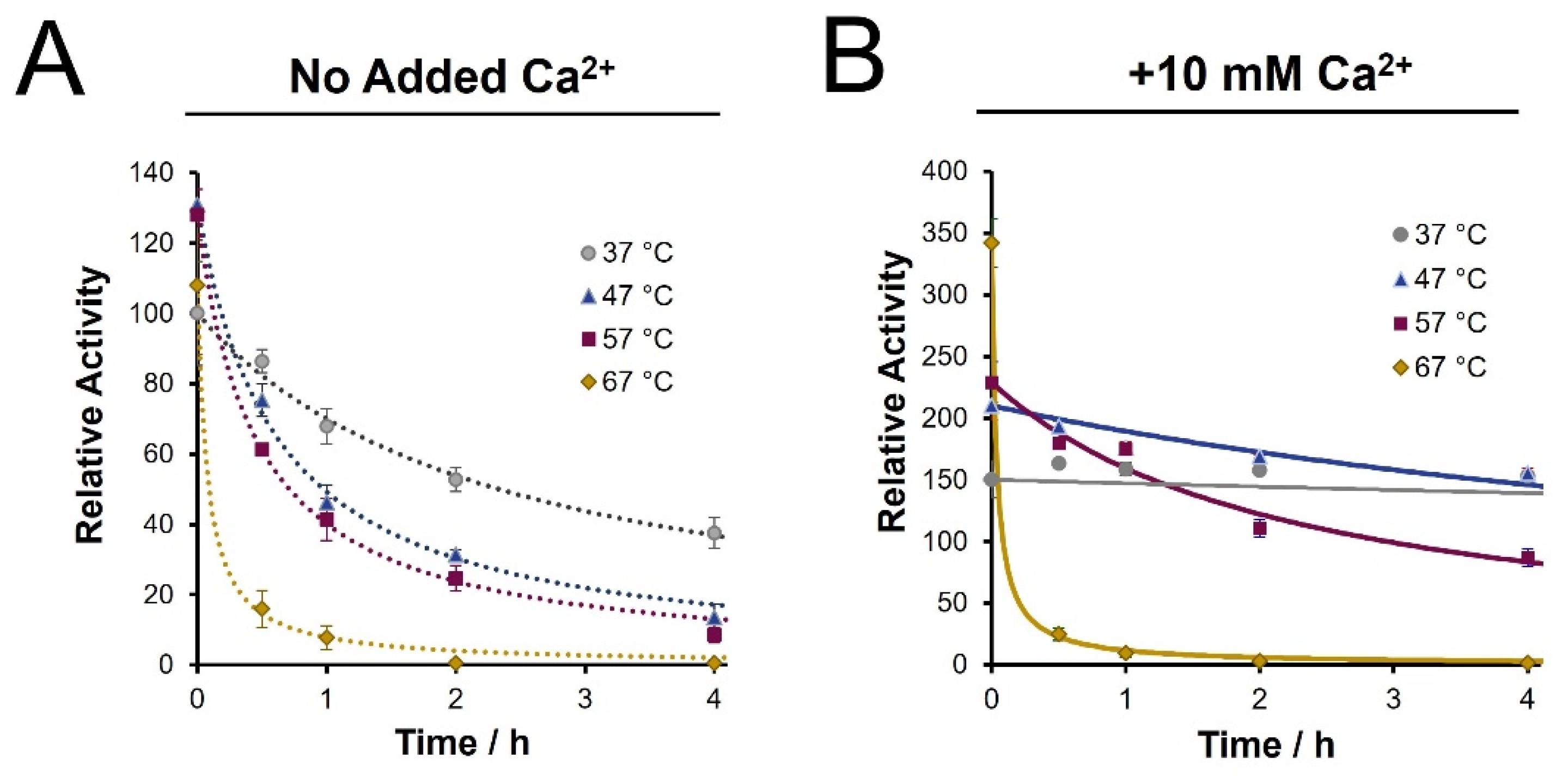
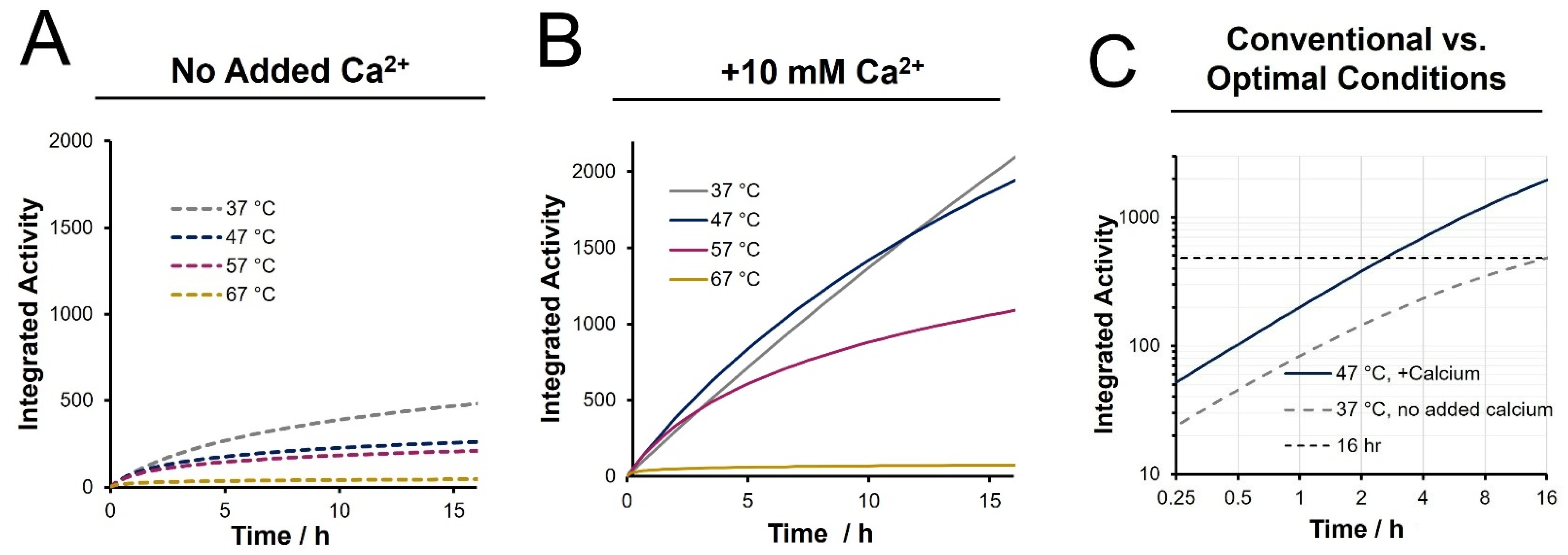
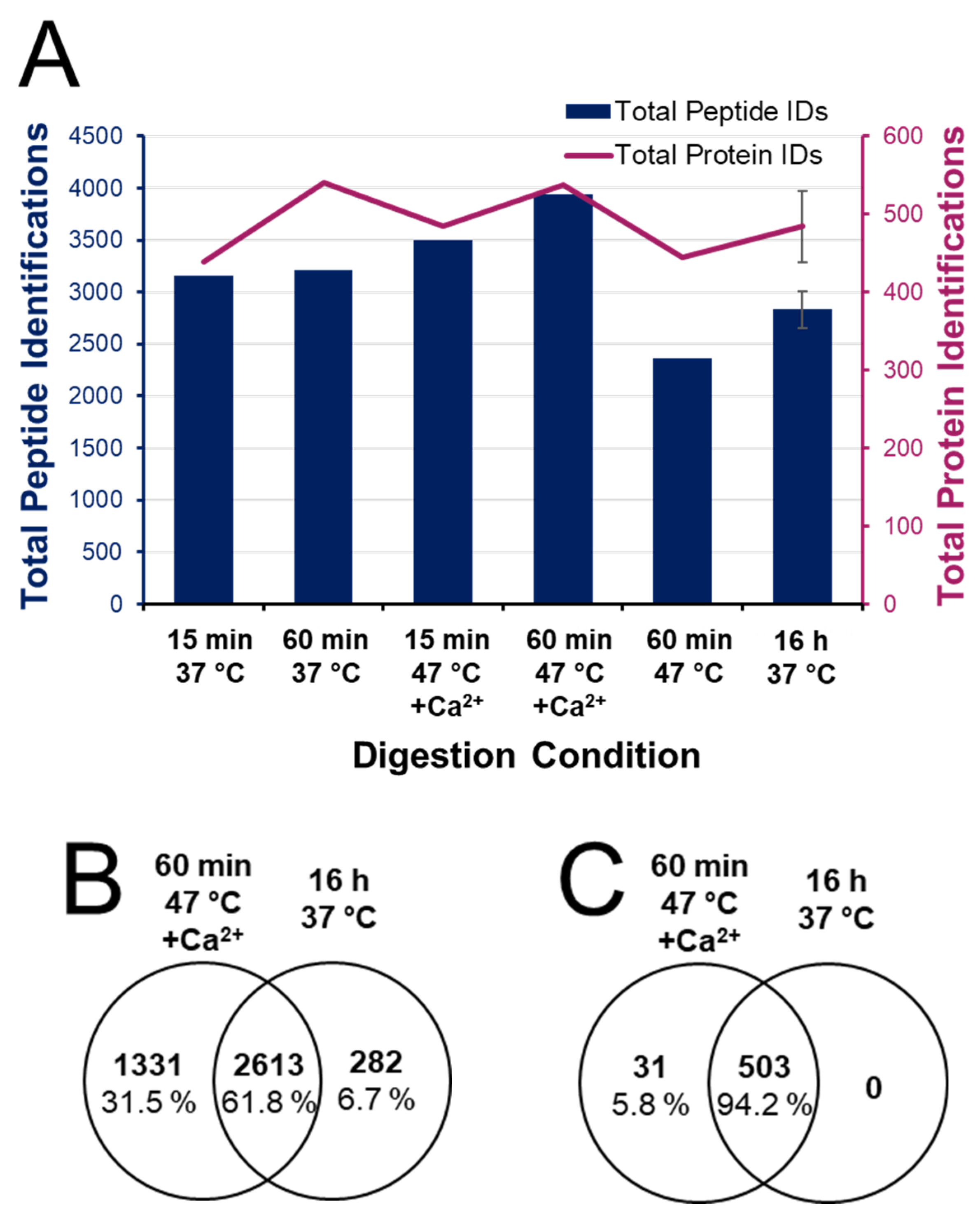

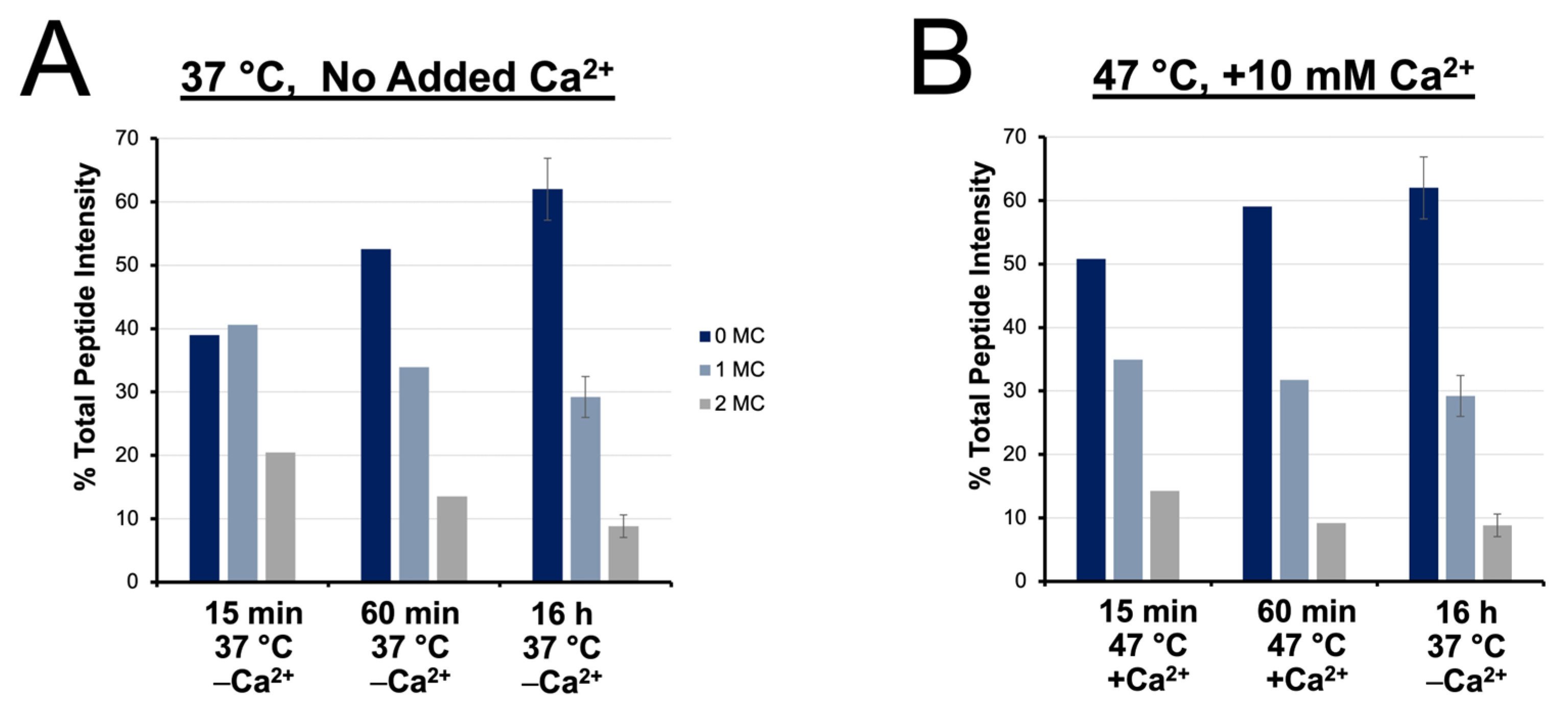
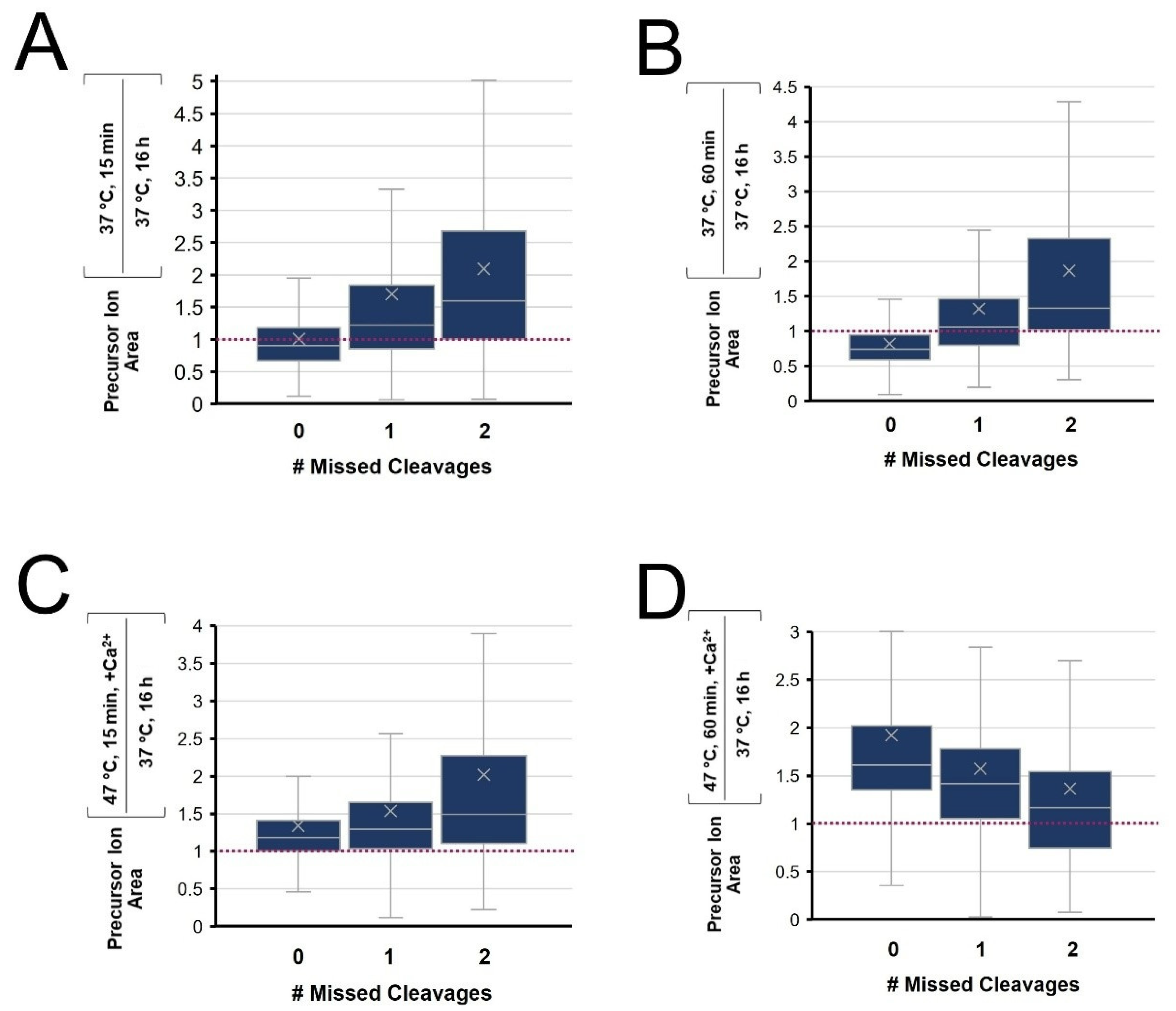



| No Added Ca2+ | +10 mM Ca2+ | |||||
|---|---|---|---|---|---|---|
| Temperature | Initial Activity/% | Rate Constant, k/h−1 | Calculated Half-Life /h | Initial Activity/% | Rate Constant, k/h−1 | Calculated Half-Life /h |
| 37 °C | 100 ± 15 | 0.004 ± 1 × 10−4 | 2.4 | 150 ± 20 | 0.0001 ± 2 × 10−5 | 51.3 |
| 47 °C | 130 ± 12 | 0.013 ± 8 × 10−4 | 0.6 | 210 ± 17 | 0.0004 ± 8 × 10−5 | 11.6 |
| 57 °C | 128 ± 7 | 0.017 ± 1 × 10−4 | 0.5 | 229 ± 16 | 0.0018 ± 2 × 10−4 | 2.4 |
| 67 °C | 108 ± 20 | 0.12 ± 8 × 10−3 | 0.03 | 340 ± 20 | 0.19 ± 0.01 | 0.03 |
Publisher’s Note: MDPI stays neutral with regard to jurisdictional claims in published maps and institutional affiliations. |
© 2022 by the authors. Licensee MDPI, Basel, Switzerland. This article is an open access article distributed under the terms and conditions of the Creative Commons Attribution (CC BY) license (https://creativecommons.org/licenses/by/4.0/).
Share and Cite
Nickerson, J.L.; Doucette, A.A. Maximizing Cumulative Trypsin Activity with Calcium at Elevated Temperature for Enhanced Bottom-Up Proteome Analysis. Biology 2022, 11, 1444. https://doi.org/10.3390/biology11101444
Nickerson JL, Doucette AA. Maximizing Cumulative Trypsin Activity with Calcium at Elevated Temperature for Enhanced Bottom-Up Proteome Analysis. Biology. 2022; 11(10):1444. https://doi.org/10.3390/biology11101444
Chicago/Turabian StyleNickerson, Jessica L., and Alan A. Doucette. 2022. "Maximizing Cumulative Trypsin Activity with Calcium at Elevated Temperature for Enhanced Bottom-Up Proteome Analysis" Biology 11, no. 10: 1444. https://doi.org/10.3390/biology11101444






